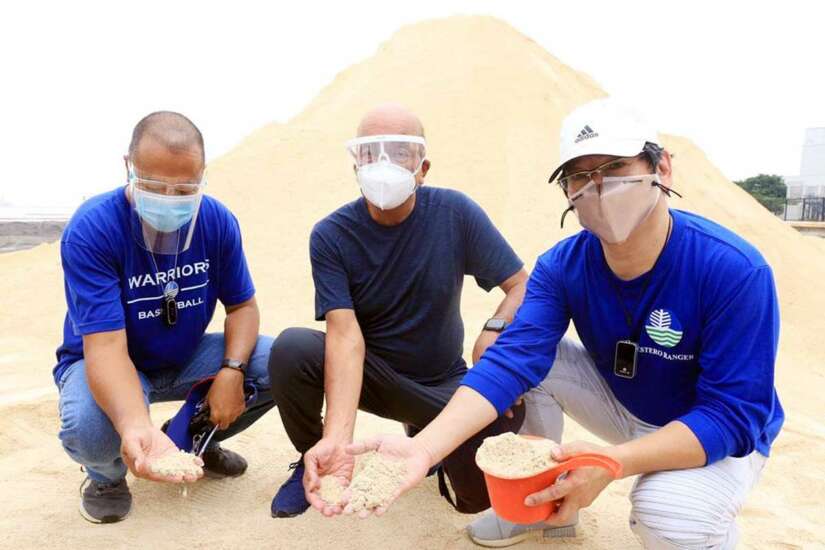THE dolomite overlay in a portion of the Manila Bay will not be totally washed out as engineering interventions have been installed along the perimeter of the sand.
This was the assurance made by Jonas Leones, Department of Environment and Natural Resources (DENR) Undersecretary for Policy, Planning and International Affairs in the midst of criticisms and apprehensions of several sectors that the budget used in procuring the dolomite sand will only go to waste as it can be easily washed away by the waters.
Leones guaranteed the structural integrity and soundness of the Manila Bay beach nourishment project, citing initial assessments conducted by its experts.
He disclosed that two sand-filled geotubes with a diameter of two meters were installed to mitigate soil erosion, prevent storm damage and provide stability to the project.
Leones added that the use of geotextile tube system is more economical than the traditional method of constructing a breakwater.
Meanwhile, Daniel Darius Nicer, Manila Bay Operations Center Head and DENR Assistant Secretary, said there is no definitive proof that any substantial portion of the dolomite beach has been washed away based on beach area and volume measurement.
Nicer noted that the alleged “washing away” of the dolomite sand was only based on the perceived discoloration of some portions of the white beach as observed from a distance.
“Due to the natural wave action of wash and backwash, greyish sand, stones, rocks and other materials piled up over the dolomite sand,” Nicer said, as he explained why certain portions of the white beach to look darker in shade.
Based on the inspection conducted by DENR experts, Nicer said around 9 to 10 inches of various sediments were found on top of the dolomite overlay.
Nicer also clarified that Dolomite Mining Corp. (DMC), which supplied the artificial white sand, has been in operation for almost two decades now, dispelling allegations that it was created for the sole purpose of supplying dolomite for the project.
In fact, Nicer said, the DMC was first issued permit to operate at Barangay Pugalo in Alcoy town, Cebu province in November 2002.
Meanwhile, the DENR is open to get advice from the experts of the University of the Philippines-Marine Science Institute (UP-MSI) with regards to the Manila Bay rehabilitation if it is free of charge.
DENR Undersecretary and Spokesperson Benny D. Antiporda said the observation of the UP-MSI experts on the bay’s rehabilitation is substantial and that their immediate assistance is highly appreciated.
However, Antiporda said that if they demand for high professional fees, they will just set aside the idea as the DENR has already its own set of experts—marine scientists, biologists and geologists—who are actively involved in the Manila Bay rehabilitation project.
“We are seeking for your immediate assistance on this matter. But if it needs a big amount of money, the funds of the people, I’m sorry but our experts are enough,” Antiporda told UP-MSI.
He also noted that DENR Secretary and Manila Bay Task Force chief Roy A. Cimatu “is not only a soldier and a pilot, but also an engineer.”
Based on the DENR’s experience, it requires a lot money to get the services of UP experts, contrary to public perception that transactions between government agencies are free.
“Every time we consult them (UP experts), we pay them so much money and people don’t know that,” Antiporda disclosed.
On Sept. 30, the UP-MSI released a statement enumerating the environmental problems in Manila Bay that need to be addressed, including poor water quality and threat of erosion.
The institution also cited the implications of using crushed dolomite boulders in the bay, among them erosion, ocean acidification, and health problems.
It lambasted the beach nourishment, saying “there are no shortcuts to a cleaner environment,” and “at most, it is a beautification effort that is costly and temporary.”
But Antiporda maintained that the project is more than just aesthetics as it is a strategy to promote pro-environment behavior among Filipinos, with the white sand inspiring people to be more mindful of their obligation to keep Manila Bay clean.
He also reassured that the funds used for the project will not be put to waste as engineering interventions are being made to prevent the artificial white sand from being washed away.
The DENR official likewise cited the warm reception and overwhelming support the project is getting from the public, proving that the government did right on rehabilitating the historic bay.

